 The Competition and Markets Authority (CMA) has imposed a record fine of £84m on the American pharmaceutical manufacturing company Pfizer and of £5.2m on its UK distributor, Flynn Pharma. The CMA found that the companies charged unfair prices to the NHS for phenytoin sodium capsules, the anti-epilepsy drug.
The Competition and Markets Authority (CMA) has imposed a record fine of £84m on the American pharmaceutical manufacturing company Pfizer and of £5.2m on its UK distributor, Flynn Pharma. The CMA found that the companies charged unfair prices to the NHS for phenytoin sodium capsules, the anti-epilepsy drug.
The price was previously regulated, but Pfizer deliberately de-branded the drug in September 2012 and immediately raised the price to Flynn Pharma by between 780% and 1600%, which, in turn, raised the price to the NHS by nearly 2600%. This made the drug many times more expensive than in any other European country.
The cost to the NHS rose from around £2m per year to around £50m in 2013. Although other generic drugs are available, there would be serious health risks to patients forced to switch drugs. The NHS thus had no alternative to paying the higher price.
 Pfizer claimed that the drug was loss-making before it was de-branded. However, the CMA calculated that this did not justify the size of the price increase; that the higher price enabled Pfizer to recover all these claimed losses within just two months.
Pfizer claimed that the drug was loss-making before it was de-branded. However, the CMA calculated that this did not justify the size of the price increase; that the higher price enabled Pfizer to recover all these claimed losses within just two months.
The usual practice is for pharmaceutical companies to charge high prices for new drugs for a period of time to enable them to recover high research and development costs. Later, the drugs become available as generic drugs that other manufacturers can produce. The price then normally falls dramatically.
Phenytoin sodium was invented many years ago and there has been no recent innovation and no significant investment. But, unlike with many other drugs, there has been no switching by the NHS because of possible dangers to patients. This has given Pfizer and its distributor considerable market power. As the CMA states in its press release:
Epilepsy patients who are already taking phenytoin sodium capsules should not usually be switched to other products, including another manufacturer’s version of the product, due to the risk of loss of seizure control which can have serious health consequences. As a result, the NHS had no alternative to paying the increased prices for the drug.
In conclusion, the CMA found that “both companies have held a dominant position in their respective markets for the manufacture and supply of phenytoin sodium capsules and each has abused that dominant position by charging excessive and unfair prices”.
Articles
Pfizer fined record £84.2m for overcharging NHS 2600% Independent, Zlata Rodionova (7/12/16)
Pfizer fined record £84.2m over NHS overcharging The Guardian, Angela Monaghan (7/12/16)
CMA fines drug firms £90m for over-charging NHS nhe (7/12/16)
Pfizer hit with record fine after hiking price of NHS epilepsy drug by 2,600pc – costing taxpayer millions The Telegraph (7/12/16)
Pfizer, Flynn Get Record Fine on 2,600% Drug Price Increase Bloomberg, Patrick Gower (7/12/16)
CMA publications
Phenytoin sodium capsules: suspected unfair pricing Competition and Markets Authority: Case reference: CE/9742-13, Competition and Markets Authority cases (updated 7/12/16)
CMA fines Pfizer and Flynn £90 million for drug price hike to NHS CMA Press Release (7/12/16)
Questions
- What are the arguments for drug companies being allowed to charge high prices for new drugs?
- How long should these high prices persist?
- Sketch a diagram to illustrate Pfizer’s price for its anti-epilepsy drug before and after it was de-branded. Illustrate the effect on Pfizer’s profits from the drug.
- What determines the price elasticity of demand for (a) a drug which is branded and unique; (b) a drug produced by a specific producer but which is generic and can be produced by a number of producers; (c) a generic drug produced by many producers?
- How should a regulator like the CMA decide what price a firm with market power should be allowed to charge?
- Under what legislation did the CMA fine Pfizer and Flynn Pharma? What is the upper limit to the fine it is able to impose? Did it impose the maximum fine on Pfizer?
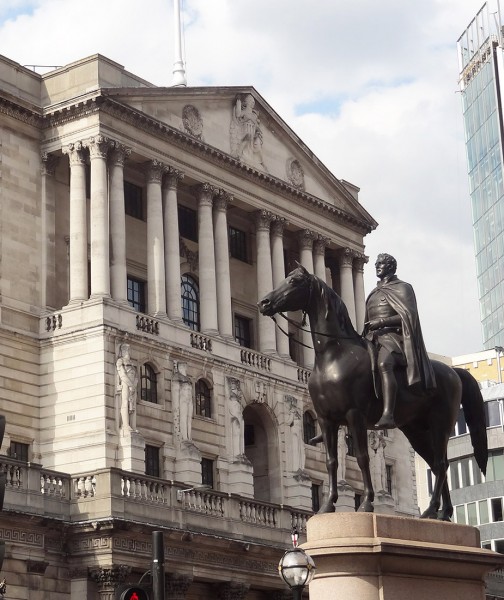 In two recent speeches, the Governor of the Bank of England, Mark Carney, and the Bank’s Chief Economist, Andy Haldane, have reflected on the growing inequality in the UK and other countries. They have also answered criticisms that monetary policy has exacerbated the problem. As, Andy Haldane puts it:
In two recent speeches, the Governor of the Bank of England, Mark Carney, and the Bank’s Chief Economist, Andy Haldane, have reflected on the growing inequality in the UK and other countries. They have also answered criticisms that monetary policy has exacerbated the problem. As, Andy Haldane puts it:
It is clear monetary policy has played a material role in lifting all boats since the financial crisis broke. …[But] even if monetary policy has lifted all boats, and could plausibly do so again if needed, that does not mean it has done so equally. In particular, concerns have been expressed about the potential distributional effects of monetary policy.
Jan Vlieghe [member of the Monetary Policy Committee] has recently looked at how monetary policy may have affected the fortunes of, among others, savers, pension funds and pensioners. The empirical evidence does not suggest these cohorts have been disadvantaged to any significant degree by the monetary policy stance. For most members in each cohort, the boost to their asset portfolios and the improved wages and profits due to a stronger economy more than offset the direct loss of income from lower rates [of interest on savings accounts].
Andy Haldane’s speech focused largely on regional inequality. He argued that productivity has grown much more rapidly in the more prosperous regions, such as London and the South East. This has resulted in rising inequality in wages between different parts of the UK. Policies that focus on raising productivity in the less prosperous regions could play a major role in reducing income inequality.
Mark Carney’s speech echoed a lot of what Andy Haldane was saying. He argued that expansionary monetary policy has, according to Bank of England modelling, “raised the level of GDP by around 8% relative to trend and lowered unemployment by 4 percentage points at their peak”. And the benefits have been felt by virtually everyone. Even savers have generally gained:
That’s in part because, to a large extent, the thrifty saver and the rich asset holder are often one and the same. Just 2% of households have deposit holdings in excess of £5000, few other financial assets and don’t own a home.
But some people still gained more from monetary policy than others – enough to contribute to widening inequality.
Losers from the lost decade
 Mark Carney looked beyond monetary policy and argued that the UK has experienced a ‘lost decade’, where real incomes today are little higher than 10 years ago – the first time this has happened for 150 years. This stalling of average real incomes has been accompanied by widening inequality between various groups, where a few have got a lot richer, especially the top 1%, and many have got poorer. Although the Gini coefficient has remained relatively constant in recent years, there has been a widening gap between the generations.
Mark Carney looked beyond monetary policy and argued that the UK has experienced a ‘lost decade’, where real incomes today are little higher than 10 years ago – the first time this has happened for 150 years. This stalling of average real incomes has been accompanied by widening inequality between various groups, where a few have got a lot richer, especially the top 1%, and many have got poorer. Although the Gini coefficient has remained relatively constant in recent years, there has been a widening gap between the generations.
For both income and wealth, some of the most significant shifts have happened across generations. A typical millennial earned £8000 less during their twenties than their predecessors. Since 2007, those over 60 have seen their incomes rise at five times the rate of the population as a whole. Moreover, rising real house prices between the mid-1990s and the late 2000s have created a growing disparity between older home owners and younger renters.
This pattern has been repeated around the developed world and has led to disillusionment with globalisation and a rise in populism.  Globalisation has been “associated with low wages, insecure employment, stateless corporations and striking inequalities”. (Click here for a PowerPoint of the chart.)
Globalisation has been “associated with low wages, insecure employment, stateless corporations and striking inequalities”. (Click here for a PowerPoint of the chart.)
And populism has been reflected in the crisis in Greece, the Brexit vote, Donald Trump’s election, the rise of the National Front in France, the No vote in the Italian referendum on reforming the constitution and the rise in anti-establishment parties and sentiment generally. Mainstream parties are beginning to realise that concerns over globalisation, inequality and a sense of disempowerment must be addressed.
Solutions to inequality
As far as solutions are concerned, central must be a rise in general productivity that increases potential real income.
Boosting the determinants of long-run prosperity is the job of government’s structural, or supply-side policies. These government policies influence the economy’s investment in education and skills; its capacity for research and development; the quality of its core institutions, such as the rule of law; the effectiveness of its regulatory environment; the flexibility of its labour market; the intensity of competition; and its openness to trade and investment.
But will this supply-side approach be enough to bring both greater prosperity and greater equality? Will an openness to trade be accepted by populist politicians who blame globalisation and the unequal gains from international trade for the plight of the poor? Carney recognises the problem and argues that:
For the societies of free-trading, networked countries to prosper, they must first re-distribute some of the gains from trade and technology, and then re-skill and reconnect all of their citizens. By doing so, they can put individuals back in control.
For free trade to benefit all requires some redistribution. There are limits, of course, because of fiscal constraints at the macro level and the need to maintain incentives at the micro level. Fostering dependency on the state is no way to increase human agency, even though a safety net is needed to cushion shocks and smooth adjustment.
Redistribution and fairness also means turning back the tide of stateless corporations.
… Because technology and trade are constantly evolving and can lead to rapid shifts in production, the commitment to reskilling all workers must be continual.
In a job market subject to frequent, radical changes, people’s prospects depend on direct and creative engagement with global markets. Lifelong learning, ever-greening skills and cooperative training will become more important than ever.
But whether these prescriptions will be accepted by people across the developed world who feel that the capitalist system has failed them and who look to more radical solutions, whether from the left or the right, remains to be seen. And whether they will be adopted by governments is another question!
Webcast
 Roscoe Lecture Bank of England on YouTube, Mark Carney (5/12/16)
Roscoe Lecture Bank of England on YouTube, Mark Carney (5/12/16)
Speeches
One Car, Two Car, Red Car, Blue Car Bank of England, Andrew Haldane (2/12/16)
The Spectre of Monetarism: Roscoe Lecture, Liverpool John Moores University Bank of England, Mark Carney (5/12/16)
Articles: Andrew Haldane speech
Bank of England chief economist says monetary stimulus stopped ‘left behind’ from drowning Independent, Ben Chu (2/12/16)
BoE’s Andrew Haldane warns of regional growth inequality BBC News (2/12/16)
‘Regions would have faced contraction’ without rate cuts and money printing Belfast Telegraph (2/12/16)
Bank of England chief: UK can be transformed if it copies progress on Teesside Gazette Live, Mike Hughes (2/12/16)
Articles: Mark Carney speech
Governor’s ‘dynamite’ warning on wages and globalisation Sky News, Ed Conway (6/12/16)
Mark Carney warns Britain is suffering first lost decade since 1860 as people across Europe lose trust in globalisation The Telegraph, Szu Ping Chan and Peter Foster (5/12/16)
Mark Carney: we must tackle isolation and detachment caused by globalisation The Guardian, Katie Allen (6/12/16)
Bank of England’s Carney warns of strains from globalization Reuters, William Schomberg and David Milliken (6/12/16)
CARNEY: Britain is in ‘the first lost decade since the 1860s’ Business Insider UK, Oscar Williams-Grut (7/12/16)
Carney warns about popular disillusion with capitalism BBC News (5/12/16)
Some fresh ideas to tackle social insecurity Guardian letters (7/12/16)
Report
Monitoring poverty and social exclusion 2016 (MPSE) Joseph Rowntree Foundation, Adam Tinson, Carla Ayrton, Karen Barker, Theo Barry Born, Hannah Aldridge and Peter Kenway (7/12/16)
Data
OECD Income Distribution Database (IDD): Gini, poverty, income, Methods and Concepts OECD
The effects of taxes and benefits on household income Statistical bulletins ONS
Questions
- Has monetary policy aggravated the problem of inequality? Explain.
- Comment on Charts 11a and 11b on page 19 of the Haldane speech.
- Does the process of globalisation help to reduce inequality or does it make it worse?
- If countries specialise in the production of goods in which they have a comparative advantage, does this encourage them to use more or less of relatively cheap factors of production? How does this impact on factor prices? How does this affect income distribution?
- How might smaller-scale firms “by-pass big corporates and engage in a form of artisanal globalisation; a revolution that could bring cottage industry full circle”?
- Why has regional inequality increased in the UK?
- What types of supply-side policy would help to reduce inequality?
- Explain the following statement from Mark Carney’s speech: “For free trade to benefit all requires some redistribution. There are limits, of course, because of fiscal constraints at the macro level and the need to maintain incentives at the micro level”.
- Mark Carney stated that “redistribution and fairness also means turning back the tide of stateless corporations”. How might this be done?
 OPEC members agreed on 30 November 2016 to reduce their total oil output by 1.2m barrels per day (b/d) from January 2017 – the first OPEC cut since 2008. The biggest cut (0.49m b/d) is to be made by Saudi Arabia.
OPEC members agreed on 30 November 2016 to reduce their total oil output by 1.2m barrels per day (b/d) from January 2017 – the first OPEC cut since 2008. The biggest cut (0.49m b/d) is to be made by Saudi Arabia.
Russia has indicated that it too might cut output – by 0.3m b/d. If it carries through with this, it will be the first deal for 15 years to include Russia. OPEC members hope that non-OPEC countries will also cut output by 0.3m b/d. There will be a meeting between OPEC and non-OPEC members on 9 December in Doha to hammer out a deal. If all this goes ahead, the total cut would represent nearly 2% of world output.
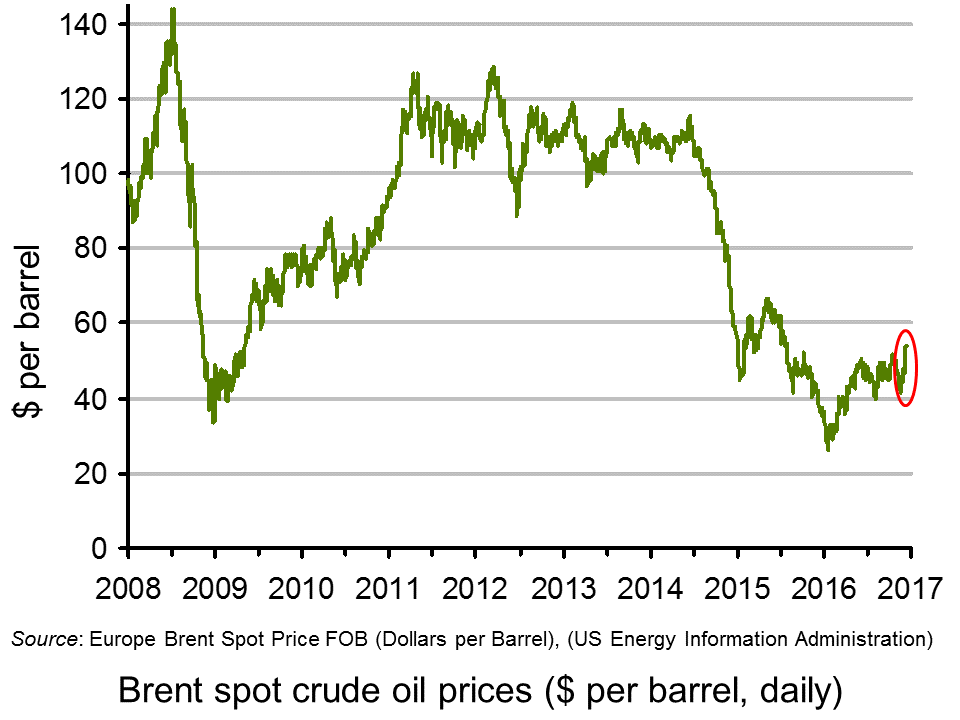 The OPEC agreement took many commentators by surprise, who had expected that Iran’s unwillingness to cut its output would prevent any deal being reached. As it turned out, Iran agreed to freeze its output at current levels.
The OPEC agreement took many commentators by surprise, who had expected that Iran’s unwillingness to cut its output would prevent any deal being reached. As it turned out, Iran agreed to freeze its output at current levels.
Although some doubted that the overall deal would stick, there was general confidence that it would do so. Markets responded with a huge surge in oil prices. The price of Brent crude rose from $46.48 per barrel on 29 November to $54.25 on 2 December, a rise of nearly 17% (click here for a PowerPoint of the chart)..
 The deal represented a U-turn by Saudi Arabia, which had previously pursued the policy of not cutting output, so as to keep oil prices down and drive many shale oil producers out of business (see the blog, Will there be an oil price rebound?)
The deal represented a U-turn by Saudi Arabia, which had previously pursued the policy of not cutting output, so as to keep oil prices down and drive many shale oil producers out of business (see the blog, Will there be an oil price rebound?)
But if oil prices persist above $54 for some time, many shale oil fields in the USA will become profitable again and some offshore oil fields too. At prices above $50, the supply of oil becomes relatively elastic, preventing prices from rising significantly. As The Observer article states:
It is more likely that a $60 cap will emerge as the Americans, who stand outside the 13-member OPEC grouping, unplug the spigots that have kept their shale oil fields from producing in the last year or two.
… The return to action of once-idle derricks on the Texas and Dakota plains is the result of efficiency savings that have seen large jobs losses and a more streamlined approach to drilling from the US industry, after the post-2014 price tumble rendered many operators unprofitable. Only a few years ago, many firms struggled to make a profit at $70 a barrel. Now they can be competitive at much lower prices, with many expecting $50 for West Texas Intermediate – a lighter crude that typically earns $5 a barrel less than Brent.
OPEC as a cartel is much weaker than it used to be. It produces only around 40% of global oil output. Cheating from its members and increased production from non-OPEC countries, let alone huge oil stocks after two years when production has massively exceeded consumption, are likely to combine to keep prices below $60 for the foreseeable future.
Webcasts
 OPEC Cuts Daily Production by 1.2 Million Barrels MarketWatch, Sarah Kent (30/11/16)
OPEC Cuts Daily Production by 1.2 Million Barrels MarketWatch, Sarah Kent (30/11/16)
 How Putin, Khamenei and Saudi prince got OPEC deal done Reuters, Rania El Gamal, Parisa Hafezi and Dmitry Zhdannikov (2/12/16)
How Putin, Khamenei and Saudi prince got OPEC deal done Reuters, Rania El Gamal, Parisa Hafezi and Dmitry Zhdannikov (2/12/16)
 Fuel price fears as OPEC agrees to cut supply Sky News, Colin Smith (30/11/16)
Fuel price fears as OPEC agrees to cut supply Sky News, Colin Smith (30/11/16)
 OPEC Confounds Skeptics, Agrees to First Oil Cuts in 8 Years Bloomberg, Jamie Webster (30/11/16)
OPEC Confounds Skeptics, Agrees to First Oil Cuts in 8 Years Bloomberg, Jamie Webster (30/11/16)
 Game of oil: Behind the OPEC deal Aljazeera, Giacomo Luciani (3/12/16) (first 10½ minutes)
Game of oil: Behind the OPEC deal Aljazeera, Giacomo Luciani (3/12/16) (first 10½ minutes)
 Russia won’t stick with its side of the OPEC cut bargain CNBC, Silvia Amaro (1/12/16)
Russia won’t stick with its side of the OPEC cut bargain CNBC, Silvia Amaro (1/12/16)
Articles
Oil soars, Brent hits 16-month high after OPEC output deal Reuters, Devika Krishna Kumar (1/12/16)
OPEC reaches a deal to cut production The Economist (3/12/16)
Opec doesn’t hold all the cards, even after its oil price agreement The Observer, Phillip Inman (4/12/16)
Saudi Arabia discussed oil output cut with traders ahead of Opec Financial Times, David Sheppard and Anjli Raval (4/12/16)
The return of OPEC Reuters, Jason Bordoff (2/12/16)
‘Unfortunately, We Tend To Cheat,’ Ex-Saudi Oil Chief Says Of OPEC Forbes, Tim Daiss (4/12/16)
After OPEC – What’s Next For Oil Prices? OilPrice.com (2/12/16)
The OPEC Oil Deal Sells Fake News for Real Money Bloomberg, Leonid Bershidsky (1/12/16)
Data and information
Brent crude prices, daily US Energy Information Administration
OPEC home page Organization of the Petroleum Exporting Countries
OPEC 171st Meeting concludes OPEC Press Release (30/11/16)
Questions
- What determines the price elasticity of supply of oil at different prices?
- Why is the long-term demand for oil more elastic than the short-term demand?
- What determines the likelihood that the OPEC agreement will be honoured by its members?
- Is it in Russia’s interests to cut its production as part of the agreement?
- Are higher oil prices ‘good news’ for the global economy and a boost to economic growth – a claim made by Saudi Arabia?
- What role does oil storage play in determining the effect on the oil price of a cut in output?
- What are oil prices likely to be in five years’ time? Explain your reasoning.
- Is it in US producers’ interests to invest in new shale oil production? Explain.
 Under the auspices of the Bank for International Settlements (BIS), banks around the world are working their way towards implementing tougher capital requirements. These tougher rules, known as ‘Basel III’, are due to come fully into operation by 2019.
Under the auspices of the Bank for International Settlements (BIS), banks around the world are working their way towards implementing tougher capital requirements. These tougher rules, known as ‘Basel III’, are due to come fully into operation by 2019.
This third version of international banking rules was agreed after the financial crisis of 2008, when many banks were so undercapitalised that they could not withstand the dramatic decline in the value of many of their assets and a withdrawal of funds.
Basel III requires banks to have much more capital, especially common equity capital. The point about equity (shares) is that it’s a liability that does not have to be repaid. If people hold bank shares, the bank does not have to repay them and does not even have to pay any dividends. In other words, the money raised by issuing shares carries no obligation on the part of the bank and can thus provide a buffer against large-scale withdrawal of funds.
Under Basel III, banks have to maintain sufficiently large ‘capital-adequacy ratios’. As Essentials of Economics (7th edition) explains:
Capital adequacy is a measure of a bank’s capital relative to its assets, where the assets are weighted according to the degree of risk. The more risky the assets, the greater the amount of capital that will be required.
A measure of capital adequacy is given by the capital adequacy ratio (CAR). This is given by the following formula:

Common Equity Tier 1 (CET1) capital includes bank reserves (from retained profits) and ordinary share capital (equities), where dividends to shareholders vary with the amount of profit the bank makes… Additional Tier 1 (AT1) capital consists largely of preference shares. These pay a fixed dividend (like company bonds), but although preference shareholders have a prior claim over ordinary shareholders on the company’s (i.e. the bank’s) profits, dividends need not be paid in times of loss.
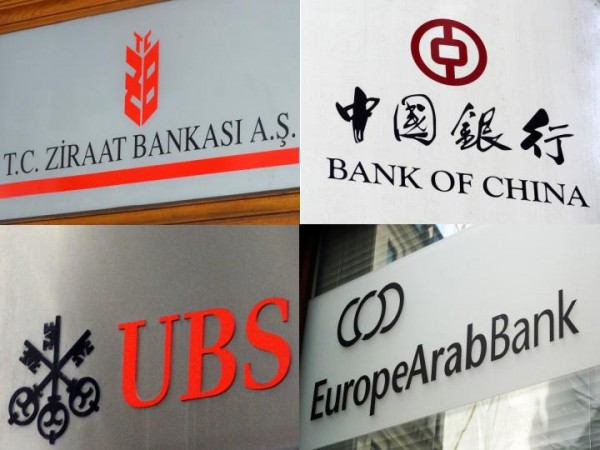 Tier 2 capital is subordinated debt with a maturity greater than 5 years. Subordinated debt holders only have a claim on a company (a bank) after the claims of all other bondholders have been met.
Tier 2 capital is subordinated debt with a maturity greater than 5 years. Subordinated debt holders only have a claim on a company (a bank) after the claims of all other bondholders have been met.
Risk-weighted assets are the total value of assets, where each type of asset is multiplied by a risk factor. Under the Basel III accord, cash and government bonds have a risk factor of zero and are thus not included. Interbank lending between the major banks has a risk factor of 0.2 and is thus included at only 20 per cent of its value; residential mortgages under 60% of the value of the property have a risk factor of 0.35; personal loans, credit-card debt and overdrafts have a risk factor of 1; loans to companies carry a risk factor of 0.2, 0.5, 1 or 1.5, depending on the credit rating of the company. Thus the greater the average risk factor of a bank’s assets, the greater will be the value of its risk weighted assets, and the lower will be its CAR.
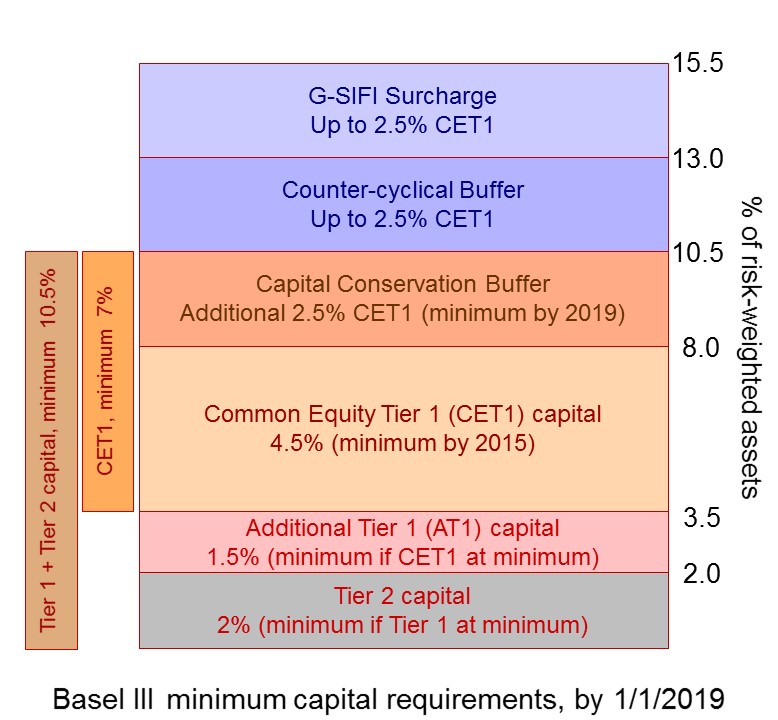 Basel III gives minimum capital requirements that are higher than under its predecessor, Basel II. Thus, by 2019, banks must have a common equity capital to risk-weighted assets of at least 4.5% and a Tier 1 ratio of at least 6.0%. The overall CAR should be at least 8%. In addition, the phased introduction of a ‘capital conservation buffer’ from 2016 will raise the overall CAR to at least 10.5 per cent.
Basel III gives minimum capital requirements that are higher than under its predecessor, Basel II. Thus, by 2019, banks must have a common equity capital to risk-weighted assets of at least 4.5% and a Tier 1 ratio of at least 6.0%. The overall CAR should be at least 8%. In addition, the phased introduction of a ‘capital conservation buffer’ from 2016 will raise the overall CAR to at least 10.5 per cent.
Over the past few years, banks have increased their capital cushions significantly and many have exceeded the Basel III requirements, even for 2019.
But the Basel Committee has been reconsidering the calculation of risk-weighted assets. Because of the complexity of banks’ asset structures, which tend to vary significantly from country to country, it is difficult to ensure that banks’ are meeting the Basel III requirements. Under proposed amendments to Basel III (which some commentators have dubbed ‘Basel IV’), banks would have to compare their own calculations with a ‘standardised’ model. Their own calculations of risk-based assets would then not be allowed to be lower than 60–90% (known as ‘the output floor’) of the standardised approach.
While, on the surface, this may seem reasonable, European banks have claimed that this would penalise them, as some of their assets are less risky than the equivalent assets in other countries. For example, Germany has argued that mortgage defaults have been rare and thus German mortgage debt should be given a lower weighting than US mortgage debt, where defaults have been more common. If all assets were assessed according to the output floor, several banks, especially in Europe, would be judged to be undercapitalised. As The Economist article states:
Analysts at Morgan Stanley estimate that global, non-American banks could see risk-weighted assets rise by an average of 18–30%, depending on the level of the output floor. Extra capital of €250bn–410bn could be needed, a tall order when earnings are thin and investors wary. The committee’s reviews of operational and market risks would add even more.
This question of an output floor was a sticking point at the Basel Committee meeting in Santiago, which ended on 30 November. Although some progress was made about agreeing to rules on risk weighting that could be applied globally, a final agreement will have to wait until the next meeting, in January – at the earliest.
Articles
Basel bust-up: A showdown looms over bank-capital rules The Economist (26/11/16)
Bank regulators fail to agree on new rules Manila Standard (2/12/16)
Bank chief Claudio Borio urges regulators to ‘stay strong’ Weekend Australian, Michael Bennet (29/11/16)
Final Basel III rules meet resistance from Europe The Straits Times (2/12/16)
This Is the Absolutely Worst Time to Weaken Global Bank Rules American Banker, Mayra Rodriguez Valladares (2/12/16)
New Basel banking rules’ impact on European economy Financial Times, Frédéric Oudéa (28/12/16)
Banks like RBS still look risky, but getting too tough could cause greater problems The Conversation, Alan Shipman (1/12/16)
BIS publications
International banking supervisory community meets to discuss the regulatory framework BIS Press Release (1/12/16)
Basel III: international regulatory framework for banks Bank for International Settlements
Basel III phase-in arrangements Basel Committee on Banking Supervision, BIS
Basel Committee on Banking Supervision reforms – Basel III, Summary Table Basel Committee on Banking Supervision, BIS
Questions
- Why do reserves in banks have a zero weighting in terms of risk-based assets?
- What items have a 100% weighting? Explain why.
- Examine the table, Basel III phase-in arrangements, and explain each of the terms.
- If banks are forced to operate with a higher capital adequacy ratio, what is this likely to do to bank lending? Explain. How are funding costs relevant to your answer?
- Explain each of the items in the Basel III capital-adequacy requirements shown in the chart above.
- What is the American case for imposing an output floor?
- What is the European banks’ case for using their own risk weighting?
- Why is it proposed that larger ‘systemically important banks’ (SIBs) should have an additional capital requirement?
- How does the balance of assets of American banks differ from that of European banks?
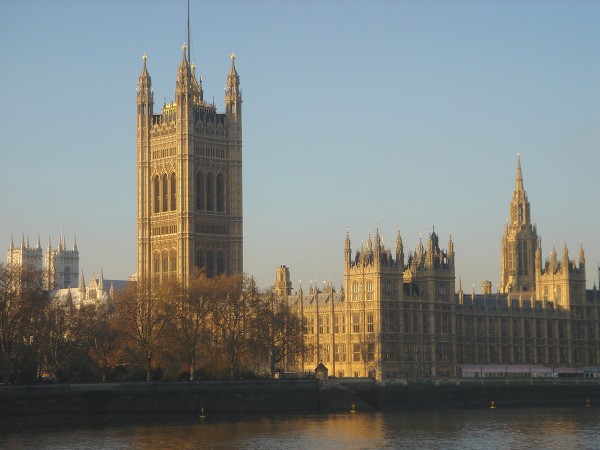 In his 2016 Autumn Statement, the new Chancellor of the Exchequer, Philip Hammond, announced that he was abandoning his predecessor’s target of achieving a budget surplus in 2019/20 and beyond. This was partly in recognition that tax revenues were likely to be down as economic growth forecasts were downgraded by the Office for Budget Responsibility. But it was partly to give himself more room to boost the economy in response to lower economic growth. In other words, he was moving from a strictly rules-based fiscal policy to one that is more interventionist.
In his 2016 Autumn Statement, the new Chancellor of the Exchequer, Philip Hammond, announced that he was abandoning his predecessor’s target of achieving a budget surplus in 2019/20 and beyond. This was partly in recognition that tax revenues were likely to be down as economic growth forecasts were downgraded by the Office for Budget Responsibility. But it was partly to give himself more room to boost the economy in response to lower economic growth. In other words, he was moving from a strictly rules-based fiscal policy to one that is more interventionist.
Although he still has the broad target of reducing government borrowing over the longer term, this new flexibility allowed him to announce increased government spending on infrastructure.
The new approach is outlined in the updated version of the Charter for Budget
Responsibility, published alongside the Autumn Statement. The government’s fiscal mandate would now include the following:
|
|
| • |
a target to reduce cyclically-adjusted public-sector net borrowing to below 2% of GDP by 2020/21; |
| • |
a target for public-sector net debt as a percentage of GDP to be falling in 2020/21. |
It also states that:
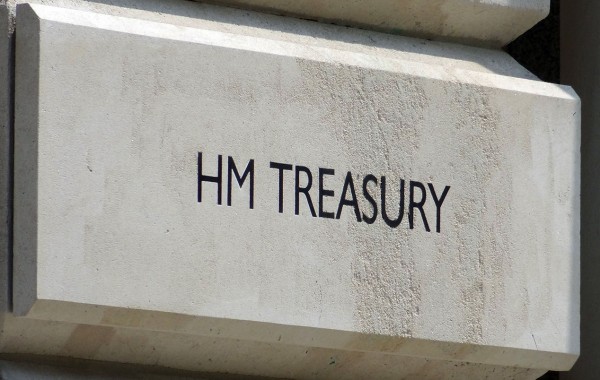 In the event of a significant negative shock to the UK economy, the Treasury will review the appropriateness of the fiscal mandate and supplementary targets as a means of returning the public finances to balance as early as possible in the next Parliament.
In the event of a significant negative shock to the UK economy, the Treasury will review the appropriateness of the fiscal mandate and supplementary targets as a means of returning the public finances to balance as early as possible in the next Parliament.
In the Autumn Statement, the new approach to fiscal policy is summarised as follows:
This new fiscal framework ensures the public finances continue on the path to sustainability, while providing the flexibility needed to support the economy in the near term.
With his new found freedom, the Chancellor was able to announce spending increases, despite deteriorating public finances, of £36bn by 2021/22 (see Table 1 in the Autumn Statement).
Most of the additional expenditure will be on infrastructure. To facilitate this, the government will set up a new National Productivity Investment Fund (NPIF)  to channel government spending to various infrastructure projects in the fields of housing, transport, telecoms and research and development. The NPIF will provide £23bn to such projects between 2017/18 and 2021/22.
to channel government spending to various infrastructure projects in the fields of housing, transport, telecoms and research and development. The NPIF will provide £23bn to such projects between 2017/18 and 2021/22.
But much of the additional flexibility in the new Fiscal Mandate will be to allow automatic fiscal stabilisers to operate. The OBR forecasts an increase in borrowing of £122bn over the 2017/18 to 2021/22 period compared with its forecasts made in March this year. Apart from the additional £23bn spending on infrastructure, most of the rest will be as a result of lower tax receipts from lower economic growth. This, in turn, is forecast to be the result of lower investment caused by Brexit uncertainties and lower real consumer spending because of the fall in the pound and the consequent rise in prices.
But rather than having to tighten fiscal policy to meet the previous borrowing target, the new Fiscal Mandate will permit this rise in borrowing. The lower tax payments will help to reduce the dampening effect on the economy.
So are we entering a new era of fiscal policy? Is the government now using discretionary fiscal policy to boost aggregate demand, while also attempting to increase productivity? Or is the relaxation of the Fiscal Mandate just a redrawing of the rules to give a bit more flexibility over the level of stimulus the government can give the economy?
Videos
 Autumn Statement 2016: Philip Hammond’s speech (in full) GOV.UK (23/11/16)
Autumn Statement 2016: Philip Hammond’s speech (in full) GOV.UK (23/11/16)
 Philip Hammond’s autumn statement – video highlights The Guardian (23/11/16)
Philip Hammond’s autumn statement – video highlights The Guardian (23/11/16)
 Key points from the chancellor’s first Autumn Statement BBC News, Andrew Neil (23/11/16)
Key points from the chancellor’s first Autumn Statement BBC News, Andrew Neil (23/11/16)
 Autumn Statement: higher borrowing, lower growth Channel 4 News, Helia Ebrahimi (23/11/16)
Autumn Statement: higher borrowing, lower growth Channel 4 News, Helia Ebrahimi (23/11/16)
 Autumn Statement: Chancellor’s growth and borrowing figures BBC News (23/11/16)
Autumn Statement: Chancellor’s growth and borrowing figures BBC News (23/11/16)
 Markets react to Autumn Statement Financial Times on YouTube, Roger Blitz (23/11/16)
Markets react to Autumn Statement Financial Times on YouTube, Roger Blitz (23/11/16)
 Hammond’s Autumn Statement unpicked Financial Times on YouTube, Gemma Tetlow (23/11/16)
Hammond’s Autumn Statement unpicked Financial Times on YouTube, Gemma Tetlow (23/11/16)
 Autumn Statement 2016: The charts that show the cost of Brexit Sjy News, Ed Conway (24/11/16)
Autumn Statement 2016: The charts that show the cost of Brexit Sjy News, Ed Conway (24/11/16)
 BBC economics editor Kamal Ahmed on the Autumn Statement. BBC News (23/11/16)
BBC economics editor Kamal Ahmed on the Autumn Statement. BBC News (23/11/16)
 Autumn statement: debate Channel 4 News, Financial Secretary to the Treasury, Jane Ellison, and Labour’s Shadow Business Secretary, Clive Lewis (23/11/16)
Autumn statement: debate Channel 4 News, Financial Secretary to the Treasury, Jane Ellison, and Labour’s Shadow Business Secretary, Clive Lewis (23/11/16)
 Autumn Statement: Workers’ pay growth prospects dreadful, says IFS BBC News, Kevin Peachey and Paul Johnson (24/11/16)
Autumn Statement: Workers’ pay growth prospects dreadful, says IFS BBC News, Kevin Peachey and Paul Johnson (24/11/16)
Articles
Autumn Statement 2016: Expert comment on fiscal policy Grant Thornton, Adam Jackson (23/11/16)
Philip Hammond loosens George Osborne’s fiscal rules to give himself more elbow room as Brexit unfolds CityA.M., Jasper Jolly (23/11/16)
Britain’s New Fiscal Mandate Opens Way To Invest For Economic Growth Forbes, Linda Yueh (23/11/16)
Autumn Statement 2016: experts respond The Conversation (23/11/16)
Chancellor’s ‘Reset’ Leaves UK Economy Exposed And Vulnerable Huffington Post, Alfie Stirling (23/11/16)
Britain’s Autumn Statement hints at how painful Brexit is going to be The Economist (26/11/16)
Chancellor’s looser finance targets highlight weaker UK economy The Guardian, Phillip Inman (24/11/16)
Hammond’s less-than-meets-the-eye plan that hints at the future Financial Times, Martin Sandbu (23/11/16)
Economists’ views on Philip Hammond’s debut Financial Times, Paul Johnson, Bronwyn Curtis and Gerard Lyons (24/11/16)
Government Publications
Autumn Statement 2016 HM Treasury (23/11/16)
Charter for Budget Responsibility: autumn 2016 update HM Treasury
Reports, forecasts and analysis
Economic and fiscal outlook – November 2016 Office for Budget Responsibility (23/11/16)
Autumn Statement 2016 analysis Institute for Fiscal Studies (November 2016)
Questions
- Distinguish between discretionary fiscal policy and rules-based fiscal policy.
- Why have forecasts of the public finances worsened since last March?
- What is meant by automatic fiscal stabilisers? How do they work when the economic growth slows?
- What determines the size of the multiplier from public-sector infrastructure projects?
- What dangers are there in relaxing the borrowing rules in the Fiscal Mandate?
- Examine the arguments for relaxing the borrowing rules more than they have been?
- If the economy slows more than has been forecast and public-sector borrowing rises faster, does the Chancellor have any more discretion in giving a further fiscal boost to the economy?
- Does the adjustment of borrowing targets as the economic situation changes make such a policy a discretionary one rather than a rules-based one?
 The Competition and Markets Authority (CMA) has imposed a record fine of £84m on the American pharmaceutical manufacturing company Pfizer and of £5.2m on its UK distributor, Flynn Pharma. The CMA found that the companies charged unfair prices to the NHS for phenytoin sodium capsules, the anti-epilepsy drug.
The Competition and Markets Authority (CMA) has imposed a record fine of £84m on the American pharmaceutical manufacturing company Pfizer and of £5.2m on its UK distributor, Flynn Pharma. The CMA found that the companies charged unfair prices to the NHS for phenytoin sodium capsules, the anti-epilepsy drug. Pfizer claimed that the drug was loss-making before it was de-branded. However, the CMA calculated that this did not justify the size of the price increase; that the higher price enabled Pfizer to recover all these claimed losses within just two months.
Pfizer claimed that the drug was loss-making before it was de-branded. However, the CMA calculated that this did not justify the size of the price increase; that the higher price enabled Pfizer to recover all these claimed losses within just two months.











